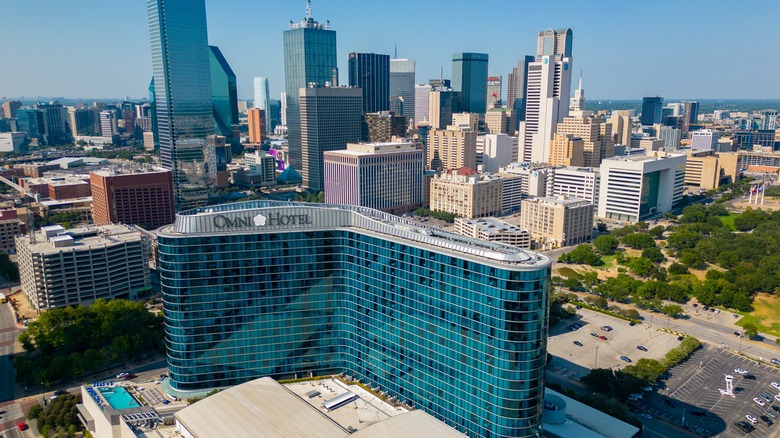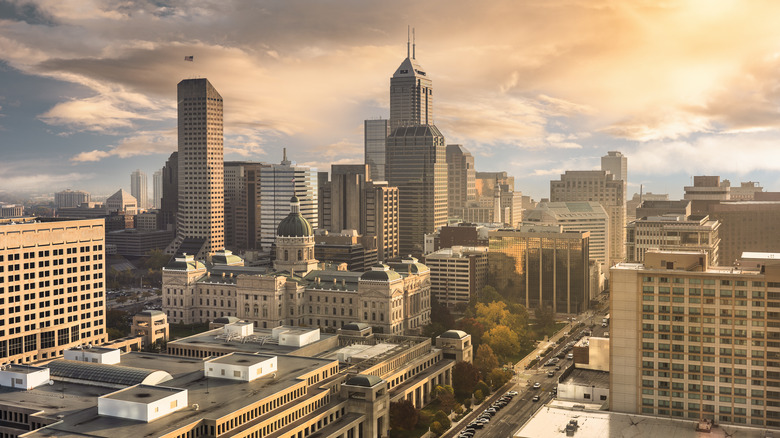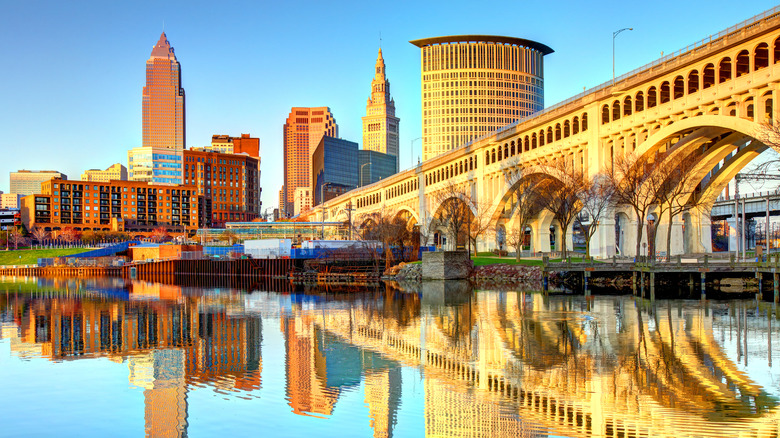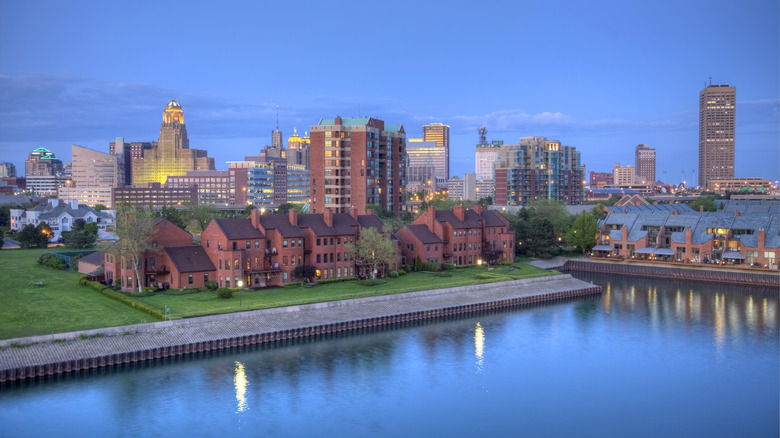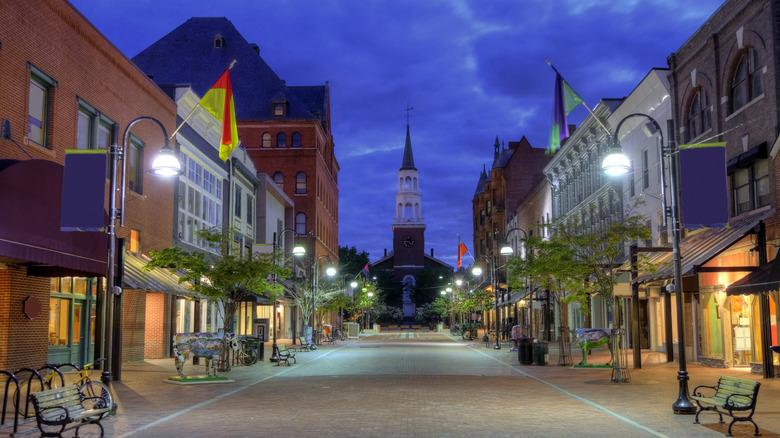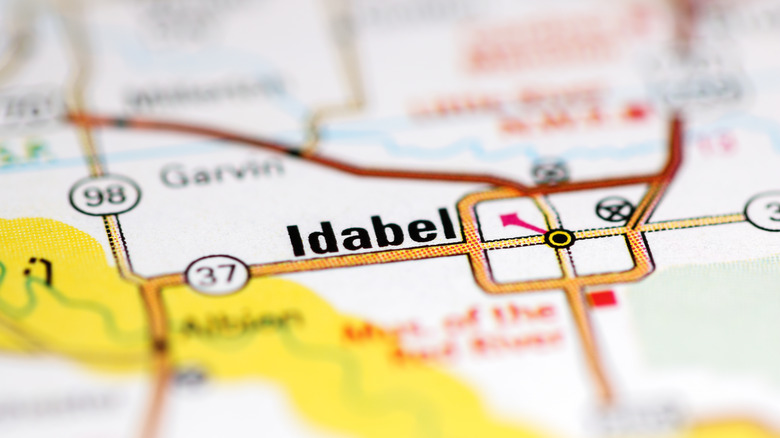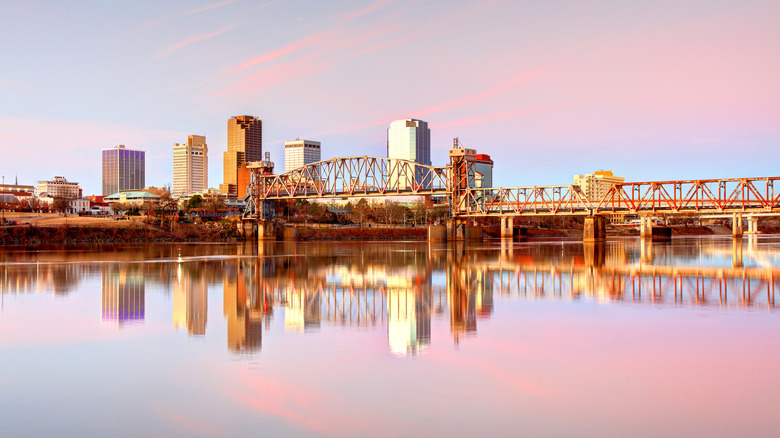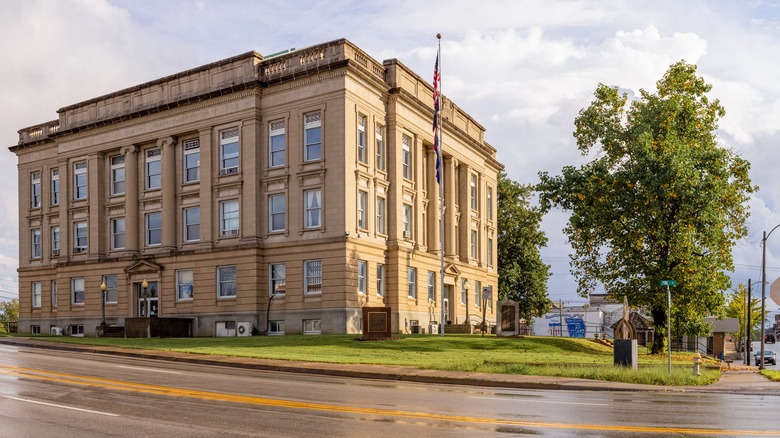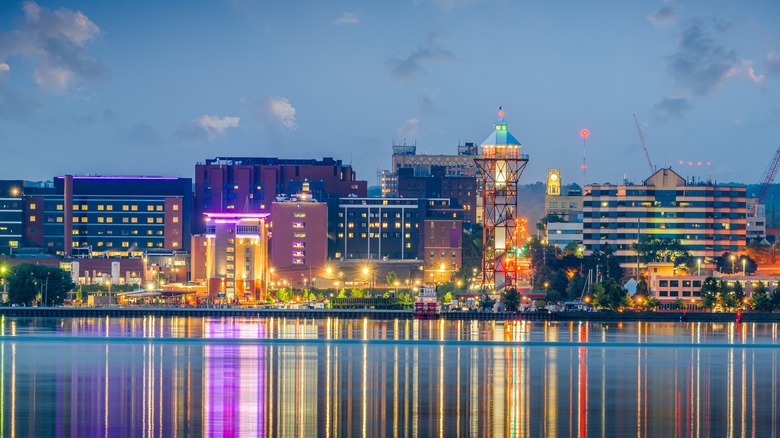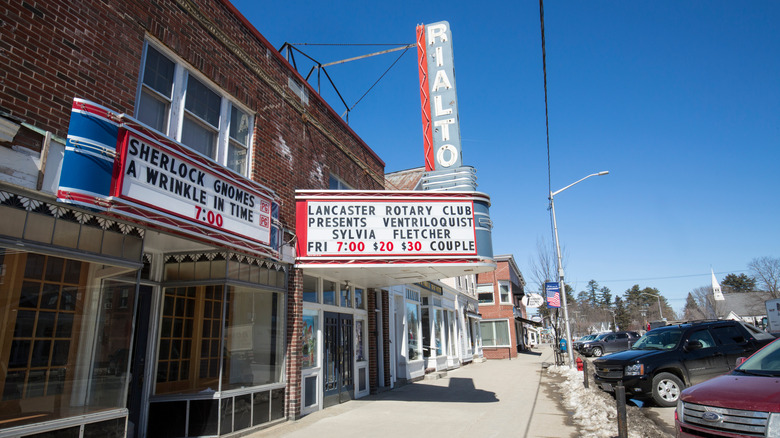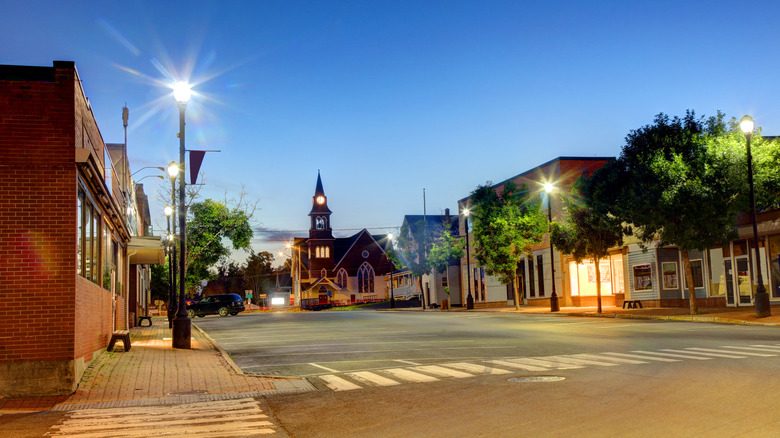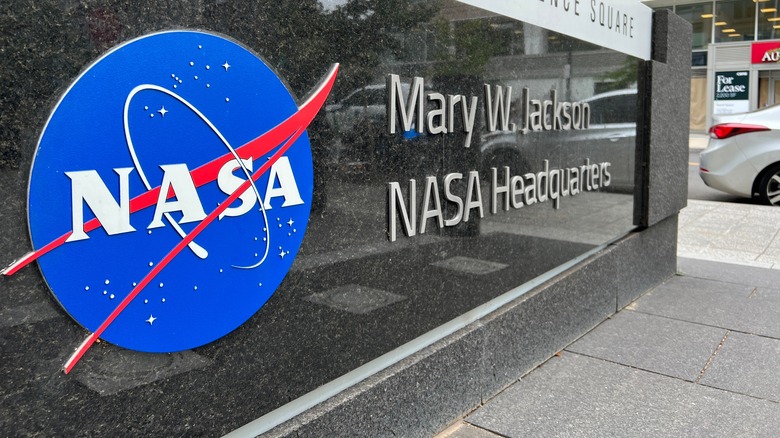The Best US Cities For Viewing The Solar Eclipse In 2024, According To NASA
It's official! NASA (among many other stargazing sources) has confirmed that a total solar eclipse will pass over North America on April 8, 2024. Almost the entire contiguous landmass of the United States sits within the eclipse's path, meaning viewers from all but essentially the Pacific Northwest (sorry, Crater Lake, you'll just have to reminisce on the previous eclipse) can walk outside at the anointed hour and catch a glimpse of this unique and fearsome celestial force.
Humans have been documenting the striking sights of lunar and solar eclipses since perhaps 3340 B.C., when an ancient Irish megalithic monument appears to have been inscribed with petroglyphs telling the story of the event. This newest occurrence will be a marvelous opportunity to see a true rarity. This will be a total solar eclipse, meaning the sun will completely disappear behind the moon, casting a vast shadow on the Earth that turns day into night, if only for a few minutes. In 2024, Americans will be graced with a wonderful opportunity to explore the sky's vast wonders again. Fortunately, NASA has offered a detailed map of the eclipse's path along with some data on the exact timings of the event, and that map informs this list of U.S. cities that lie directly on the way and make for the best possible view.
Dallas, Texas
The total solar eclipse will pass over the United States, traveling in a northeasterly direction, ranging from Texas to Maine. It will start over the Pacific Ocean and initially show itself to landbound viewers in Mexico (at about 11 a.m. local time). The first major American city that will experience the sun's majestic blackout will be Dallas, Texas. This means that visitors flocking to the Lone Star State can catch some of the first glimpses of the phenomenon. The partial begins at 12:23 p.m. local time, with the total eclipse starting at 1:40 p.m. and ending at 1:44 p.m. The eclipse's maximum is at 1:42 p.m., and the partial's end comes nearly three hours after the event begins, at 3:02 p.m.
Dallas and its surroundings will almost assuredly be a popular destination for visitors from all over the country and the wider world since the eclipse will only cut across North America and then fade out over the Atlantic. It's estimated that over 1 million visitors will flock to the state because it will offer the best chance for clear skies along the path, and Texas skies will boast the "longest possible duration of totality anywhere in the U.S. — at 4 minutes, 26 seconds," according to Jamie Carter (of Space.com). Dallas offers a great variety of rooftop viewing spots and other social gathering opportunities that can make for a magical experience.
Indianapolis, Indiana
Indianapolis, and Indiana more broadly, is likely to experience the next highest volume of visitors (after Texas) flocking to experience the eclipse's path of totality. Space.com's GIS-based analysis suggests that Indianapolis is the closest viewing destination for people living in Chicago, Milwaukee, Louisville, and perhaps even Cincinnati. With several large metro areas seemingly set to filter their eager onlookers toward Indianapolis and its suburbs, the community will host large-scale celebrations and viewing opportunities. One such event will be NASA's own broadcast, hosted at the legendary Indianapolis Motor Speedway. Visitors can camp here and get up close and personal with NASA astronauts and scientists for a truly remarkable celestial viewing experience.
The eclipse will last for 3 minutes and 46 seconds over Indianapolis, taking place at 3:06 p.m., with the partial eclipse beginning at 1:50 p.m. and ending at 4:23 p.m. With a variety of excellent events tied into the phenomenon here — including at Indianapolis' Children's Museum, and Newfields, the Indianapolis Museum of Art's campus — there's something for everyone on the hunt for a social viewing experience.
Cleveland, Ohio
Cleveland will see the start of the eclipse's partial coverage at 1:59 p.m. local time. The event will last until 4:29 p.m., allowing visitors and native Cleveland onlookers more than two hours to marvel at the spectacle. Totality will begin over Cleveland at 3:13 p.m. and last until 3:17 p.m., with the eclipse's maximum at 3:15 p.m.
As is the case with many cities lucky enough to have this year's eclipse pass directly over their community, C-Town won't see another total solar eclipse for a very long time — a whopping 420 years! While Cleveland is an excellent hub for those traveling from around Ohio and even Detroit and other southeastern Michigan communities, plenty of smaller towns throughout the state will experience the path of totality. This lends itself to the potential for Ohioans to simply stay put for the eclipse. The city will certainly draw its share of travelers, but this is unlikely to rise to the levels seen across Texas or in Indianapolis, just a few hours to Cleveland's west. The Cleve will make for a tremendous community-focused space to view the event, however. Great Lakes Science Center has partnered with NASA's Glenn Research Center and the Cleveland Orchestra to put on the Total Eclipse Fest, running from April 6 to 8 at North Coast Harbor (located downtown). Visitors attending the festival will enjoy a free concert and participate in a wide range of hands-on scientific experiences rolled out by the NASA research team.
Buffalo, New York
Buffalo is perfectly positioned as a big enough city to offer relatively easy transportation from anywhere in the country and is just 25 minutes from Niagara Falls. The falls provide a fantastic vantage point to take in the astronomic event, not surprising considering they are one of the most iconic natural landscapes in America and a real bucket list destination. Whether you make the short journey to this border town or not, picturesque scenery can be found in abundance. Buffalo sits right in the centerline of the eclipse's path, meaning viewers looking skyward from this upstate New York metro area will enjoy a truly awe-inspiring view of the sun's disappearance. The eclipse's partial begins at 2:04 p.m. local time and lasts until 4:32 p.m., providing a good window to marvel at the event. The maximum will take place at 3:20 p.m., with the window of totality lasting from 3:18 p.m. to 3:22 p.m.
Upstate New York also has varied alternatives for viewing the event. For those who may not be interested in sharing this special moment with a large crowd of people, it's possible to take solace in the fact that Cleveland (to the west) and places like Rochester and Burlington in the east are all relatively close and serve as closer viewpoints in areas surrounding New York and New Jersey. Buffalo won't be the calmest place to see the sun get gobbled up, but it certainly won't be as packed as many other big destinations.
Burlington, Vermont
Burlington is the final 'big' city where viewing the solar eclipse is possible in the territorial United States. The center of its path passes right over The Queen City, providing a wonderful view of the eclipse for onlookers in this New England locale. Burlington offers wonderful scenery mixed perfectly with a quaint yet bustling community backdrop. Burlington is also just a 150-mile drive (a little under two and a half hours by car) from Brattleboro, a quirky New England town that's absolutely perfect for an unforgettable Vermont getaway. Combining a visit to see the eclipse with jetting off to Brattleboro for a stunning view of the Connecticut River Valley and its surrounding hills sounds fabulous, right?
Burlington is a stunning place to take in the eclipse, and it's a fantastic option for anyone already in the nation's northeast. The city's best viewing positions are mostly found within the community's abundance of parks: Waterfront Park, Oakledge Park, and Battery Park, for instance. You might also consider hiking in the area around Burlington to get an even more nature-enhanced experience. Visitors looking to crane their neck skyward in Burlington will have until 3:27 p.m. local time to get into position (the eclipse's maximum). However, the partial begins at 2:14 p.m. and the totality will last from 3:26 p.m. to 3:29 p.m. — and the partial eclipse will end at 4:37 p.m.
Idabel, Oklahoma
Idabel is a town in southeastern Oklahoma and closer to Dallas than Tulsa or Oklahoma City. It is the first community listed here that isn't a major metro area, and this can make for a marvelous change of pace when viewing the natural scene above. Idabel was home to just 7,004 people in 2021, making it a truly small town.
The so-called Dogwood Capital of Oklahoma is also home to the Little River National Wildlife Refuge, and numerous other park areas in the state's southeastern corner can make for a wonderful viewpoint, thanks to their close proximity to Idabel, which sits right on the path of totality. Idabel itself will enjoy nearly three hours of eclipse activity. The partial coverage of the sun will begin at 12:28 p.m. and last until 3:06 p.m. Totality begins at 1:45 p.m. and lasts through the maximum at 1:47 p.m. and ends at 1:49 p.m.
Little Rock, Arkansas
Little Rock is the capital of Arkansas and a truly historic town, yet it remains a relatively small community perfect for outdoor enthusiasts and nature buffs looking to experience the eclipse. The path of totality runs through a large majority of the state, and nearby Lake Maumelle (which will experience a three-and-a-half minute totality) and Pinnacle Mountain State Park offer spectacular outdoor viewing spaces right in the heart of the great outdoors. These natural backdrops are less densely populated destinations that might provide the perfect vantage point to experience the wonderous awe of a total eclipse. For a more "official" experience, visitors heading to Arkansas might consider the 70-minute drive to Russellville, just 77 miles northwest. NASA will also be broadcasting from this site, so people looking for a smaller local destination for viewing the eclipse alongside space agents would be wise to think of Little Rock.
Little Rock will see the partial begin at 12:33 p.m. local time, with the event lasting until 3:11 p.m. when the partial eclipse ends. Totality begins over Little Rock at 1:51 p.m. and lasts until 1:54 p.m., with the maximum occurring at 1:52 p.m.
Poplar Bluff, Missouri
Poplar Bluff is a town of just under 17,000 situated roughly at the crossroads between Arkansas, Missouri, Tennessee, and Kentucky. Known as the Gateway to the Ozarks, the city is about two and a half hours south of St. Louis and about the same heading north from Memphis. The city is a notable place to view the eclipse because it lies very centrally within the path of totality. Residents and visitors will experience totality for four minutes and eight seconds, making it the longest stretch of eclipse totality than any other sizeable community, according to the Poplar Bluff Chamber of Commerce. The community will offer free shuttles to and from various events that will be hosted throughout the town, including educational events featuring appearances by former astronauts. The town is also putting on the Total Eclipse of the Bluff music festival and a road race that includes a 1.7-mile walk and 6K and half marathon runs.
The maximum totality will take place over Poplar Bluff at 1:56 p.m. local time, and the partial will run from 12:39 p.m. to 3:15 p.m. Totality begins at 1:56 p.m. over the Missouri community and lasts until 2:00 p.m.
Paducah, Kentucky
Just over the state border between Illinois and Kentucky, Paducah is another small town that will be a phenomenal vantage point for eclipse hunters. Known as Quilt City USA, Paducah has a population of around 26,000 people and is littered with fantastic parks, including the Greenway Trail, a 5-mile outdoor space between Noble Park and the Convention Center downtown.
This small community will play host to a number of events, as well. The X Marks the Spot Downtown Festival will take place on April 7 and 8, building up to the eclipse on the latter. The event will feature live music and a variety of themed learning opportunities, along with delicious street food and many other features. Paducah will also play host to the Heaven and Earth Psychic Fair for those looking for unique souvenirs or maybe a reading of the future while everyone gazes skyward. Paducah will see the partial begin at 12:42 p.m., with the eclipse lasting until 3:18 p.m. The maximum will take place at 2:01 p.m., and the totality will run from 2:00 p.m. to 2:02 p.m.
Evansville, Indiana
The community of Evansville is pressed right up against the Ohio River and right along the border with Kentucky in Indiana's far southwestern corner, making it a quality option for travelers coming into the Hoosier State from Illinois or even parts of Tennessee, Kentucky, or Missouri. Evansville is an alternative viewing spot to Indianapolis, albeit 172 miles and nearly three hours down the road. There's quite a bit of real estate separating the northern chunk of Indiana from its southern reaches, so it will act as a sort of secondary hub for travelers looking to take in the eclipse without having to commit to a massive undertaking in terms of travel. Evansville sits very close to the path of totality's centerline, and locations like the Evansville Museum are hosting viewing events that are sure to make your experience something special.
Evansville will see the eclipse begin at 12:45 p.m., with the maximum occurring at 2:04 p.m. Totality will last from 2:02 p.m. to 2:05 p.m. before the partial ultimately ends a little over an hour later at 3:20 p.m.
Erie, Pennsylvania
Sat right along Lake Erie in northwestern Pennsylvania, Erie is about two hours due north of Pittsburgh and just an hour and a half east of Cleveland. This makes it a solid option for Ohioans hoping to take in the eclipse without having to brave the crowds that are certain to descend on one of Ohio's largest cities. Erie will play host to its own spectacle during the eclipse, though, and isn't just a close alternative to Cleveland or other nearby destinations. There are dozens of parks in and around the Gem City and the local community areas that are spread out throughout Erie. Other popular tourist draws like the city's Bayfront District and Presque Isle State Park can also make for a fabulous day while taking in this unique sight.
Viewers in Erie will experience the eclipse's maximum at 3:18 p.m. and see the totality between 3:16 and 3:20 p.m. The eclipse will be visible over Erie between 2:02 p.m. local time and 4:30 p.m. when the partial finally ends.
Lancaster, New Hampshire
With an eclipse maximum scheduled for 3:29 p.m., Lancaster is a great place to spend your afternoon gazing at the sun's transcendent movement. The partial will begin over Lancaster at 2:16 p.m., local time, and last until the sun's complete return from behind the moon at 4:38 p.m. Totality will begin at 3:27 p.m. and last until 3:30 p.m.
The New Hampshire city is a fantastic option for anyone hoping to view the eclipse from a nature-dominated perspective. Lancaster sits in the shadows of Mount Cabot and Mount Washington and is surrounded by forests like Cape Hork State Forest, Kauffmann Forest, White Mountain National Forest, and the Nash Stream Forest Natural Area. The Israel River runs right through the quaint and peaceful community of Lancaster, and the city also borders the Connecticut River. Whether you're thinking of finding a hotel room and staying local or venturing away to get out into the depths of nature for the eclipse, Lancaster is a great spot to consider.
Caribou, Maine
Caribou is the most remote viewing point on this list, but it's not a place that eclipse chasers will want to rule out entirely. Caribou is found all the way up near the extreme northern edge of Maine and is, in fact, the most northeasterly city in the U.S. It's just 10 minutes from the Canadian border, so anyone from the Great White North looking to travel down to American shores from the eclipse might consider a visit to Caribou. This is a small town built right up along the Aroostook River and sporting a population of just 7,000, and it might be the perfect viewing landscape for this spectacular show for nature lovers looking to get far away from the beaten path. The partial will begin at 2:22 p.m. local time, and the eclipse will last until 4:40 p.m. The maximum takes place at 3:33 p.m., and the totality will run from 3:32 p.m. to 3:34 p.m.
The Caribou community (as well as others around the county) will be hosting four days of events leading up to the eclipse, making a getaway to this northern haven a magnificent opportunity for an elongated viewing experience.
Methodology
All of the cities and towns listed are specifically noted by NASA as being great options for viewing the eclipse. Every city chosen sits firmly within the path of totality, and each provides a lengthy window for viewing not just a partial glimpse of the event but a front-row seat for the full spectacle.

